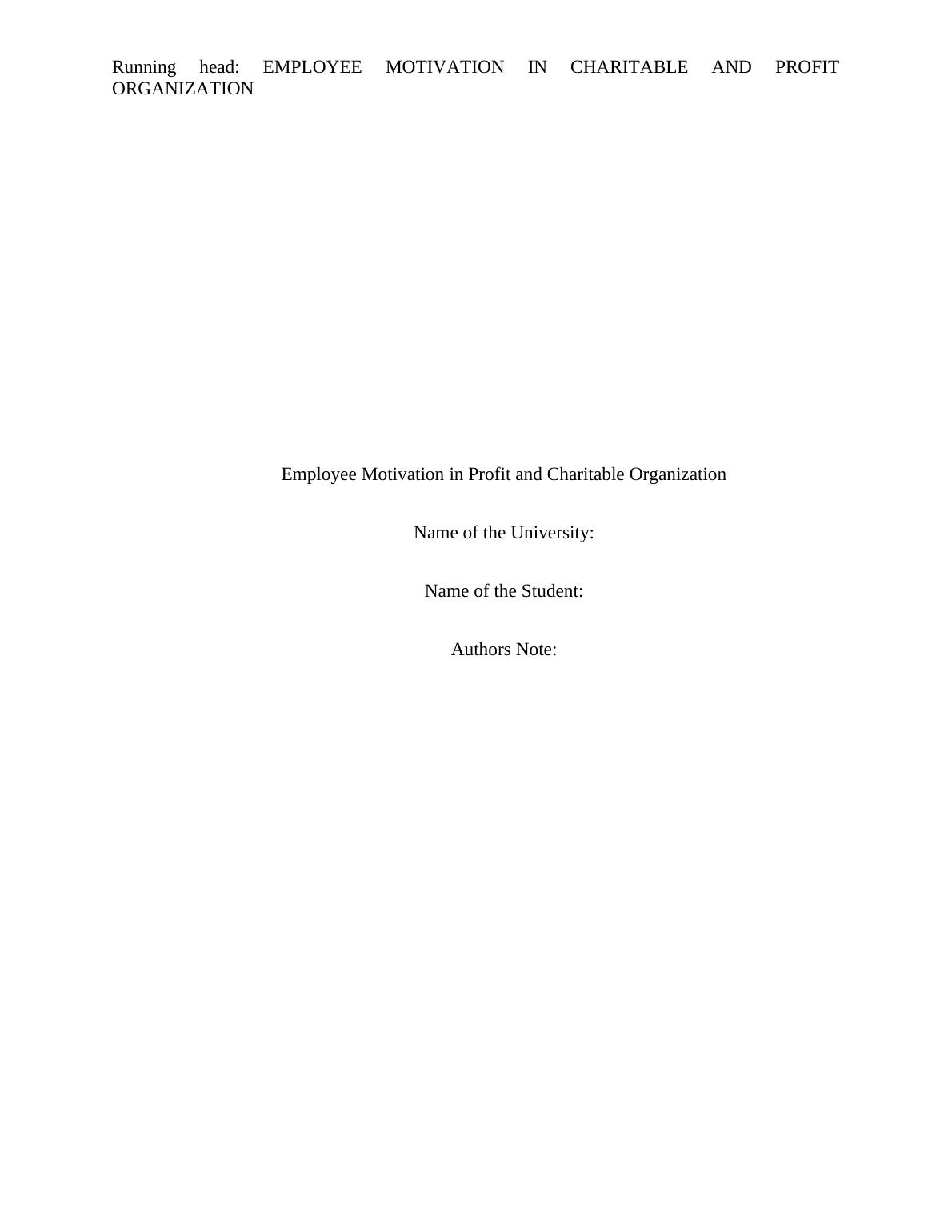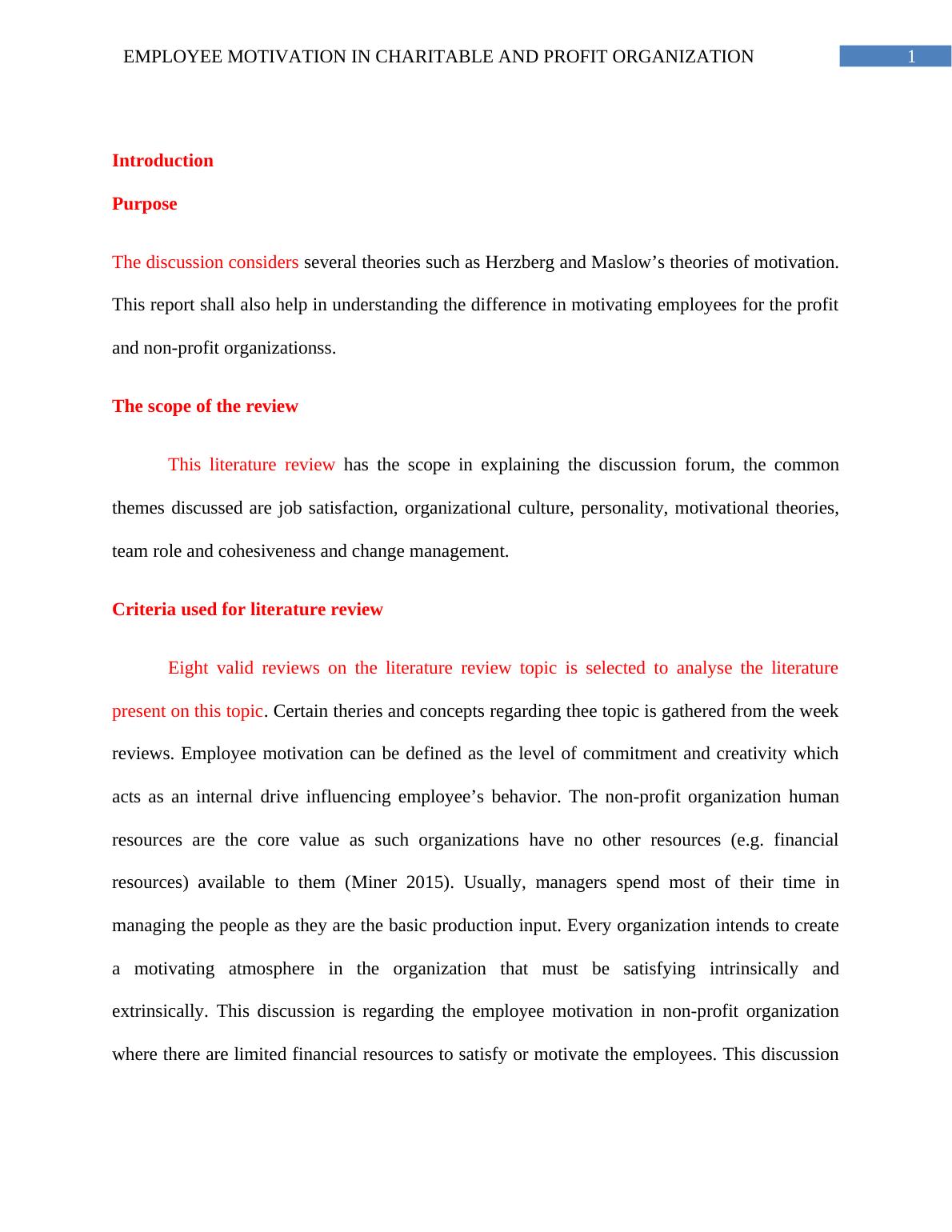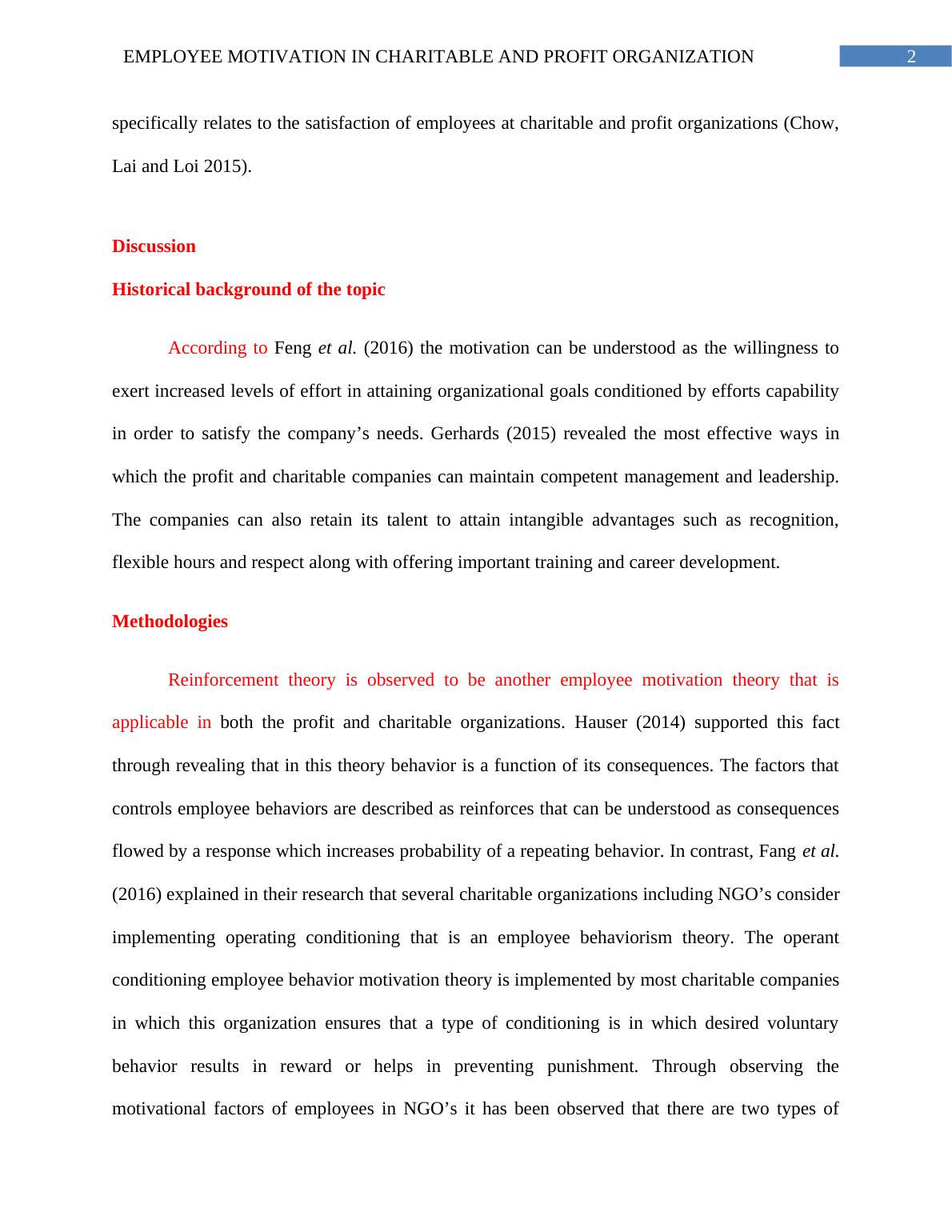(PDF) A Study of Employee Motivation in Organization
Added on 2021-04-17
14 Pages3629 Words30 Views
Running head: EMPLOYEE MOTIVATION IN CHARITABLE AND PROFITORGANIZATIONEmployee Motivation in Profit and Charitable OrganizationName of the University:Name of the Student:Authors Note:

EMPLOYEE MOTIVATION IN CHARITABLE AND PROFIT ORGANIZATION1IntroductionPurposeThe discussion considers several theories such as Herzberg and Maslow’s theories of motivation.This report shall also help in understanding the difference in motivating employees for the profitand non-profit organizationss.The scope of the reviewThis literature review has the scope in explaining the discussion forum, the commonthemes discussed are job satisfaction, organizational culture, personality, motivational theories,team role and cohesiveness and change management.Criteria used for literature reviewEight valid reviews on the literature review topic is selected to analyse the literaturepresent on this topic. Certain theries and concepts regarding thee topic is gathered from the weekreviews. Employee motivation can be defined as the level of commitment and creativity whichacts as an internal drive influencing employee’s behavior. The non-profit organization humanresources are the core value as such organizations have no other resources (e.g. financialresources) available to them (Miner 2015). Usually, managers spend most of their time inmanaging the people as they are the basic production input. Every organization intends to createa motivating atmosphere in the organization that must be satisfying intrinsically andextrinsically. This discussion is regarding the employee motivation in non-profit organizationwhere there are limited financial resources to satisfy or motivate the employees. This discussion

EMPLOYEE MOTIVATION IN CHARITABLE AND PROFIT ORGANIZATION2specifically relates to the satisfaction of employees at charitable and profit organizations (Chow,Lai and Loi 2015). DiscussionHistorical background of the topicAccording to Feng et al. (2016) the motivation can be understood as the willingness toexert increased levels of effort in attaining organizational goals conditioned by efforts capabilityin order to satisfy the company’s needs. Gerhards (2015) revealed the most effective ways inwhich the profit and charitable companies can maintain competent management and leadership.The companies can also retain its talent to attain intangible advantages such as recognition,flexible hours and respect along with offering important training and career development.MethodologiesReinforcement theory is observed to be another employee motivation theory that isapplicable in both the profit and charitable organizations. Hauser (2014) supported this factthrough revealing that in this theory behavior is a function of its consequences. The factors thatcontrols employee behaviors are described as reinforces that can be understood as consequencesflowed by a response which increases probability of a repeating behavior. In contrast, Fang et al.(2016) explained in their research that several charitable organizations including NGO’s considerimplementing operating conditioning that is an employee behaviorism theory. The operantconditioning employee behavior motivation theory is implemented by most charitable companiesin which this organization ensures that a type of conditioning is in which desired voluntarybehavior results in reward or helps in preventing punishment. Through observing themotivational factors of employees in NGO’s it has been observed that there are two types of

EMPLOYEE MOTIVATION IN CHARITABLE AND PROFIT ORGANIZATION3reinforces or outcomes that includes positive and negative reinforcement. Positive reinforcementis understood as an event that is employed by most charitable companies in increasing theoccurrence of certain responses. On the other hand, negative reinforcement is observed to becertain event when removed enhances the response frequency. Considering the same, Hauser(2014) evidenced that in order to maintain desired behavior of the employees certain profitorganizations considers elimination of a response because of reinforcement discontinuation.They also consider continuous reinforcement in which these profit organizations can praise all itsemployees for all the correct responses. Moreover, partial reinforcement is also maintained bythe profit organizations in which they consider rewarding their employees in a variable or non-continuous manner. CriticMostafa, Gould‐Williams and Bottomley (2015) explained in their research that equitytheory is highly implemented within the charitable organizations in which the employeecompares their job outcomes or inputs in comparison to relevant others and then considerscorrecting for any inequity. There are certain choices selected by the charitable organizations indealing with inequity. These choices include changing inputs or shack off, change outcomes orincreasing output and through changing self perceptions. Moreover, several profit organizationsalso consider certain choices in order to deal with inequity that includes changing the perceptionof others, selecting a different referent person and leaving the field or job. Considering suchscenario, Mustafa, Gould‐Williams and Bottomed (2015) revealed in consideration to previousliterature that there are certain propositions related to inequitable pay. Over-rewarded hourlyemployees produce more than equitability rewarded employees and the over rewarded pricework employees’ produces less but does a better quality piece work. It is also gathered that over-

End of preview
Want to access all the pages? Upload your documents or become a member.
Related Documents
Report on Strategic Management in Non-profit Organizationlg...
|15
|4016
|41
Motivation and Organizational Behavior Assignmentlg...
|22
|3956
|24
Literature Review on Expectancy Theory and Organizational Efficiencylg...
|4
|795
|239
Effect of Job Satisfaction & Motivation on Employee Performancelg...
|69
|10605
|64
Money and Other Rewards as Motivators for Employees: Pros and Conslg...
|8
|2464
|164
Performance Appraisal: A Critical Comparison of Two Research Paperslg...
|8
|2023
|224
